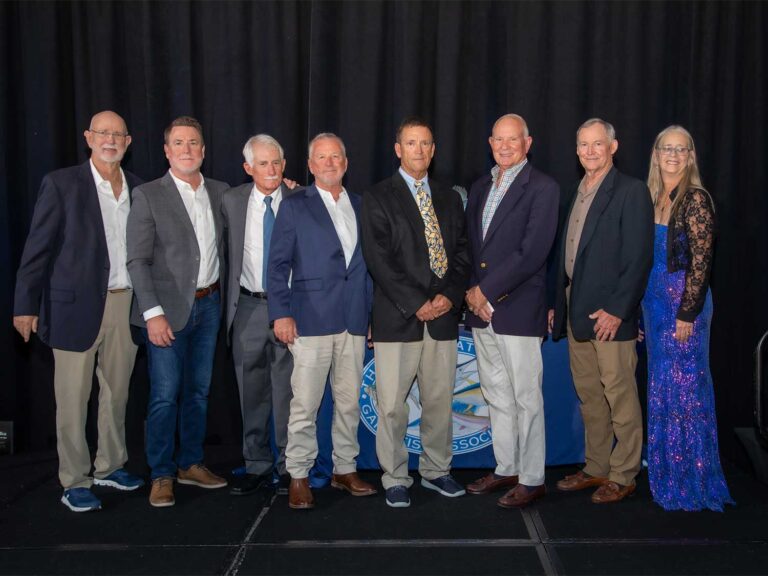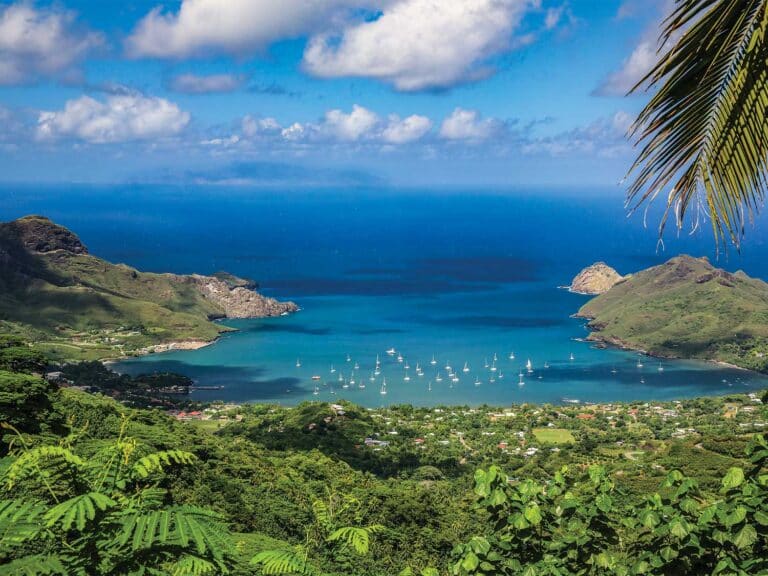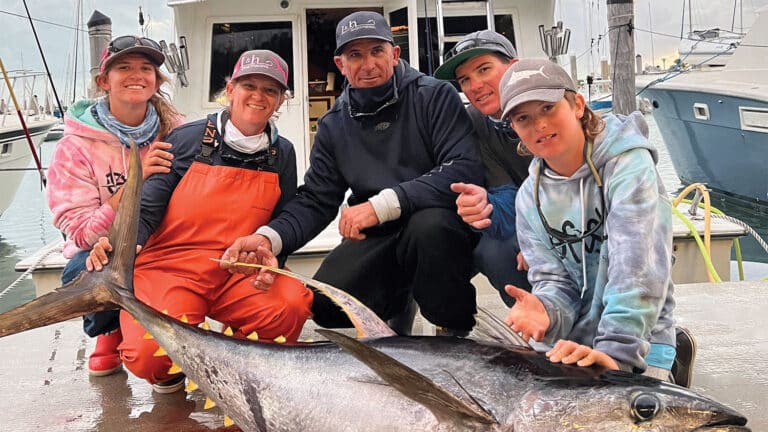
Special delivery: Sign up for the free Marlin email newsletter. Subscribe to Marlin magazine and get a year of highly collectible, keepsake editions – plus access to the digital edition and archives.
The very origins of our sport are built around fishermen who were willing to push boundaries and test the limits of their boats, their equipment and even themselves. The urge to go out farther to find bigger fish or different species—as well as explore the relative unknown—is a primal one. And while today’s technology in boats, electronics and forecasting has made fishing long distances from shore safer and more accessible than ever before, the ocean remains the great equalizer, and no trip offshore should be taken lightly.
Two of the most prominent areas in the US beyond the standard day-trip range are in the Gulf of Mexico and on the East Coast, specifically from the mid-Atlantic on up through the Northeast. And while the fishing itself can vary widely between these two zones, the same principles in preparation and safety exist for both. Fishing 100-plus miles offshore and staying out multiple days and nights can give you access to some unique fishing experiences, but it’s not for the faint of heart or the ill-prepared. I spoke to some industry veterans of these fisheries to get their perspective on long-range trips and how to make yours safer and more enjoyable.
The Gulf: Long Runs, Big Fish
If you’ve been paying attention for the past couple of decades or so, it’s no surprise that the southern states bordering the Gulf of Mexico produce some impressive blue marlin catches annually, not to mention a host of tournaments that award millions in prize money. What some outside the Gulf states may not be aware of is the distance and commitment that’s often required to chase these South Coast pelagics.
The foundation of the Gulf of Mexico fishery is provided by eddies that break off from the Loop Current and the structure provided by both the natural bottom features and the hundreds of oil rigs and platforms in the northern and western Gulf. While the rigs exist farther inshore as well, the captains I spoke with reported their common runs to reach these areas to be around 150 to 250 miles. One of the main reasons is to find a productive area with the least possible fishing pressure, especially in a tournament situation.
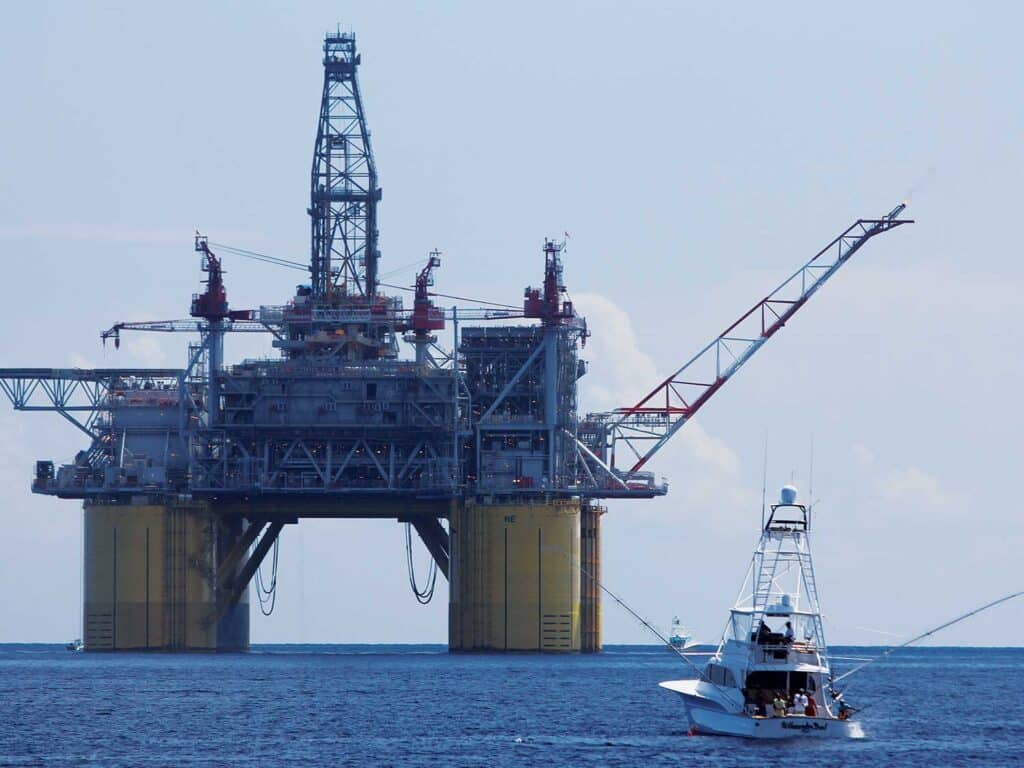
“Looking at a Hilton’s chart before a tournament, we’re trying to fish a rig that’s in one of those eddies that are spinning off the main current,” says Capt. Jeremy Cox, who runs the 72-foot Viking Lolita and is one of the founders of the Mongo Offshore Challenge. “The rigs are giant FADs that seem to always hold bait. While you don’t want it ripping, you really want there to be some current there to make it easier to find blue marlin, and we find most of the tunas up-current from the rigs and the marlin just up-current from where the tunas and bait are holding.”
And bait is key to catching the jumbo Gulf Coast blues. While trolling is still utilized in the fishery, the majority of the serious tournament fishermen these days are live-baiting. Nighttime is usually dedicated to filling up the tuna tubes for the following days’ fishing by using diamond jigs a few hours before sunrise. The goal is for every tube to be filled by daybreak, and each captain stressed the need for fresh bait. To keep the tubes topped off, small lures like dusters and squid skirts are used to troll for small tunas during the daylight hours as well.
The Gulf Coast blue marlin tournaments have grown into some of the largest and richest in the US, and from about May to September are held from the west coast of Florida all the way around to Texas. Their formats are typically a three-day long-weekend affair so boats can make the long runs and stay offshore throughout the tournament. Capt. Chase Lake, who runs the 72-foot Viking Team Supreme, has certainly made his mark on the fishery over the years, and he and his team had an absolutely incredible 2023 season that included winning the Gulf Coast Triple Crown Championship. And while blue marlin are the main event, he also describes the incredible fishing ecosystem the area offers, from bottom fishing to pelagics. “In addition to everything else, we can also catch white marlin at 60 to 90 miles and have a really good fishery for swordfish and tunas as well,” Lake says.
Capt. Scooter Porto is another Gulf tournament veteran; he runs the 68-foot Viking Fleur de Lis out of Orange Beach, Alabama, and has seen the best the area has to offer. “My best trip was about three years ago on a fun-fishing trip with my crew and our wives and we were 12 for 13 on blue marlin, plus a white in 2½ days. It was smoking fishing, and they were all 300-to-500-pounders,” Porto says.
He also notes the potential for truly big blue marlin. Just last year, the crew aboard Best Trait brought home a giant 1,145-pound blue marlin after an overnighter to set a new record for both the state of Alabama and the Gulf of Mexico.
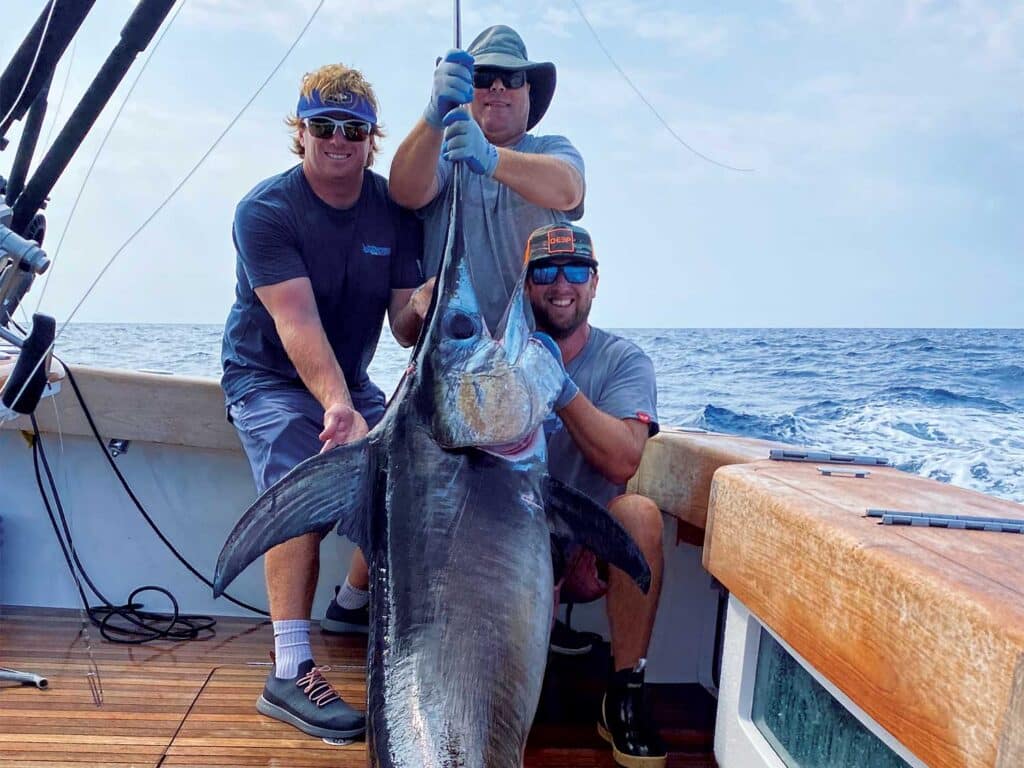
The Northeast: Canyon Runs for Banner Days (and Nights)
As the Gulf Stream current weaves its way north along the Atlantic coast, it pushes farther offshore and edges along the many canyons that cross the Northeast’s continental shelf. Northeast fishermen are notoriously hardcore, routinely blasting distances of 100 to 160 miles offshore to reach the most productive areas. The canyons offer a variety of species to target in a single trip, and a few captains have chosen to utilize multiday or 36-hour trips to maximize their catch-to-fuel-burn ratios. Being close to some of the country’s largest city centers, choosing to push farther offshore can help separate you from the crowds that often line up at the familiar inshore spots.
Capt. Willie Zimmerman runs charters aboard the 65-foot Guthrie RoShamBo out of Ocean City, Maryland, and his 36-hour charters have been a hit with clients wanting a unique experience offshore. He offers these trips from June to October, and they usually start with a 4 a.m. departure and return the following day around 5 p.m. They typically fish around 100 to 120 miles offshore anywhere from the Lindenkohl Canyon on the north end down to areas below the Norfolk Canyon to the south, and all points in between. “It’s kind of a bucket-list trip for a lot of people,” Zimmerman says. “People who have never been offshore at night get to see flying fish, squid and mackerel in the lights. We can catch marlin, tuna, dolphin, swords and bottomfish all in the same trip, so it can be pretty special.” Zimmerman’s program usually starts by trolling for tuna and billfish when he gets to the break, or bailing dolphin if the opportunity arises. He likes to be in the canyon trolling for bigeyes in the last two hours of light until about 10 p.m., when he’ll start drifting for swordfish. They start bigeye fishing again a couple of hours before daybreak, then troll for tuna and finish the trip deep-dropping for tilefish or other bottom dwellers. “It’s all about having a plan before you go out there,” he says. “It may change a little based on what’s going on at the time, but our goal is always to catch as many limits on as many different species as we can and come home with a full fish box at the end of the trip.”
Capt. Mark Decabia runs his long-range trips farther north up the East Coast out of Shinnecock, New York. He runs the 52-foot Viking Rebel and spends about 270 days a year offshore both recreational and commercial fishing between the Northeast and Florida. His fishing can be 120 to 160 miles offshore to reach the more distant canyons. Decabia says that working farther offshore and getting away from the crowds can yield some incredible results if you’re prepared for the trip. “All those eastern canyons have fewer people that can reach them, so fishing is generally better because there’s less pressure, especially if you’re there in the right conditions,” he explains. “It’s arguably one of the best fisheries on the planet; you’ve just gone out 130 miles, and sometimes the weather can be horrible. But there are very few places that you can catch eight or nine different pelagic species in an afternoon.” And Decabia says the fishing has only improved over the past few years. He describes incredible fishing for both blue and white marlin, along with bluefin, yellowfin and bigeye tuna, as well as quality in both size and numbers of tuna. “The next fish could be 5 pounds or 900 pounds; you just have no idea what’s gonna bite out there,” Decabia says. He tells me that the usual window for the Northeast canyon season is May through September, with July typically being the peak.

Planning Is Everything
When planning to fish long range, the fishing is the easy part. Spending the night this far offshore is not a trip to be thrown together last minute, especially for those without any experience doing so.
As fishermen, checking wind and wave forecasts is nothing new, but it becomes more crucial when nights at sea and multiple days are involved. These are not trips to attempt to cut it close against a threatening weather window. Conditions change quickly even in the best of times, and if you’ve not experienced a forecast much different offshore from what was expected, then I’d really like to use your weatherman. Hope for the best, but be ready for anything.
Knowing your fuel range is obviously another important consideration when covering extended miles. Since most boats in the Gulf are typically running to the fishing grounds, they carry fuel bladders of varying sizes based off the distance they plan to go and their boat’s fuel burn. While the same is possible in the Northeast, the captains I spoke to typically didn’t use bladders but took more time chugging out or when moving between areas at 10 knots to conserve fuel. It’s much better to come home with fuel to spare than push the limit to get back to the inlet.
We’re all fired up for a big trip when we leave the dock, but as much as you may want to fish around the clock, we all need sleep. The captains I spoke to all discussed the importance of creating watch and sleep schedules for themselves and the crew to ensure that everyone stays on top of their game. “A lot of time when we’re tournament fishing at night, we’re on the move,” Lake says. “I like to let the mates sleep as much as possible, so I typically bring another guy with me. There’s a ton of commercial traffic in the Gulf, so I have an extra guy I bring for tournaments so I can get a rest. Having that one more guy just to keep my mates fresh so they don’t have to keep doing wheel watches, I think that’s really big for morale.” It’s important to remember that being this far offshore exposes you to many busy shipping lanes, so make sure whoever mans the helm is alert and understands how to read the radar, use the radio and avoid other vessels.
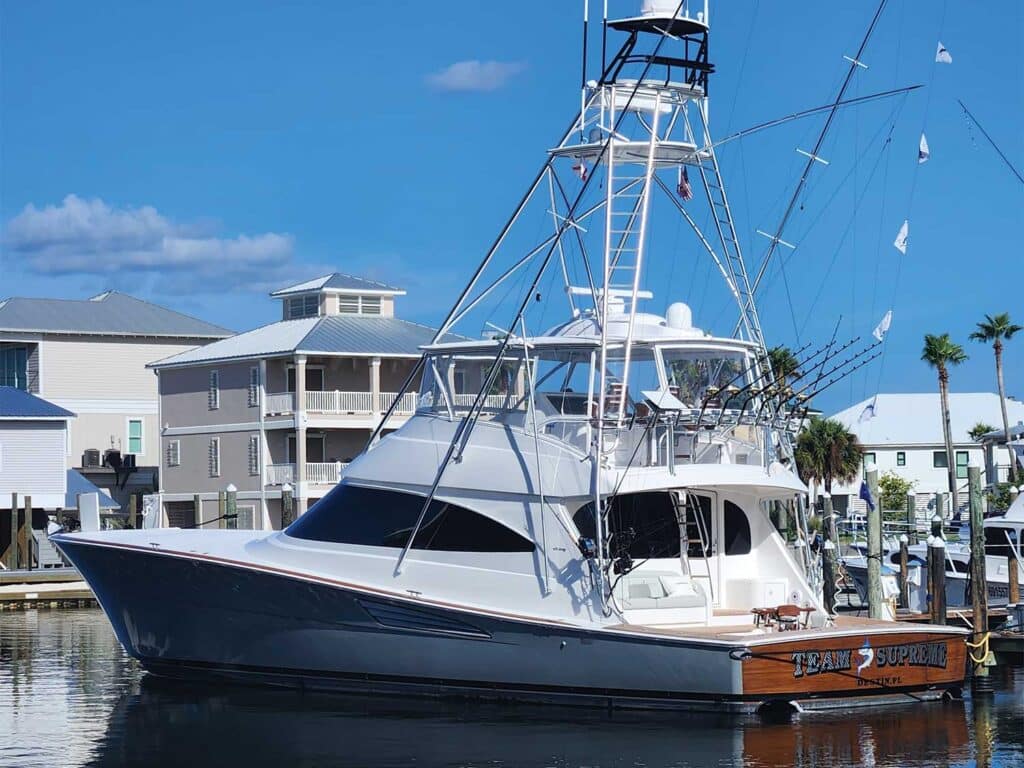
Safety is Priority One
Every captain I spoke to stressed that there’s almost no limit to the number of things that could potentially go wrong with this type of mission, so your planning should take everything into consideration, from emergency gear and preventive maintenance to spare parts with the tools to replace them. As Decabia told me, “Safety is the No. 1 priority, and there’s so much that people take for granted. It’s not a matter of if something is going to happen out there, but when.”
Emergency equipment should be aboard, and checked regularly to ensure it’s in good working order. Life rafts, EPIRBs, life jackets, fire extinguishers and flares are standard equipment for most larger vessels, but make sure your team knows where they are and how to use them. You should also have a ditch bag ready to go with emergency equipment and rations for multiple days at sea. Brush up on your basic first aid and CPR training so you’re prepared for all types of situations. The captains I spoke to noted that they kept an automatic external defibrillator on their boats. An AED is simple to use and can save someone’s life. Even a helicopter isn’t going to reach you quickly in these areas, so your preparation and training could literally be the difference between life and death.
Knowing your boat, keeping it maintained and being capable of making repairs at sea are paramount to safe long-range operation. If you depend on a mechanic for every engine-room task, then you’d better invite him along. While keeping your engines and generators running is obviously key, systems like refrigeration and air conditioning are also vital. Be sure these are in good working order, and keep a plethora of spare parts and filters for the inevitable failures. Decabia notes that you can’t be too prepared. “I bring everything possible. We carry a spare battery in the battery box, a tow rope and a portable crash pump that you can plug into an electric-reel plug or someone’s battery. A lot of people don’t realize that there’s no one out there to help you. Even if I don’t need help, someone else might.”
Read Next: Interested in fishing the Bermuda Triple Crown?
Starlink has become all the rage to keep the sport-fishing community connected offshore, and it’s a useful tool in this application as well. Satellite phones are always encouraged as a backup, and a handheld VHF could be a lifesaver in the event of something like a lightning strike. The Gulf captains told me that offshore oil platforms almost always have a nurse or medical professional onboard, so this can be a useful resource for a medical situation in these areas. In addition, cell service is available from some carriers within range of the oil rigs. Some of the Northeast captains also mentioned that they like to make these trips with a buddy boat. Not only does this help you cover ground and find productive areas in a vast canyon, but it’s always helpful to have a friend out there if you need them.
The long-range fishing out of both the Northeast and the Gulf of Mexico can offer some of the best fishing opportunities in the United States. With variety in species and potential for big fish away from the crowd, these fisheries are a unique experience for those looking to explore the far ends of their backyard. The downside is that the consequences can be massive if you’re not up for the task. Spending the night at sea creates a myriad of challenges, and being far from shore means the chance and speed at which you can get assistance in an emergency are greatly reduced. But for those who are adequately prepared, the rewards can be well worth it, and these long-range fisheries have the potential to give you a unique experience that rivals those overseas without you ever hopping on a plane.




